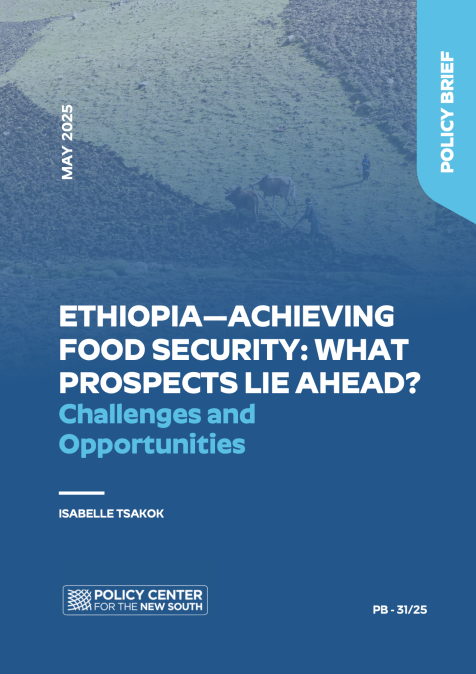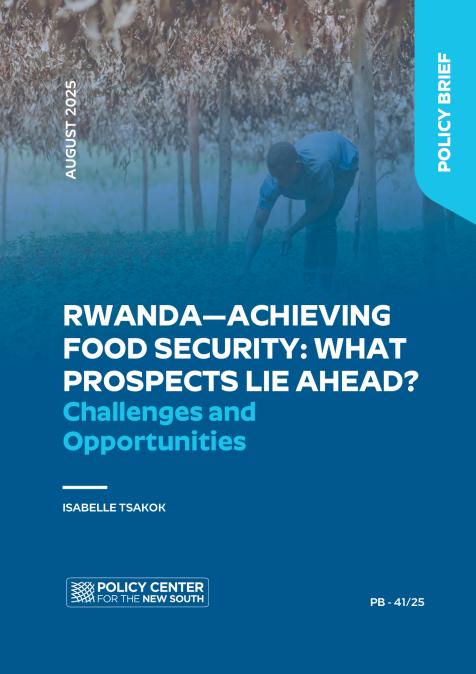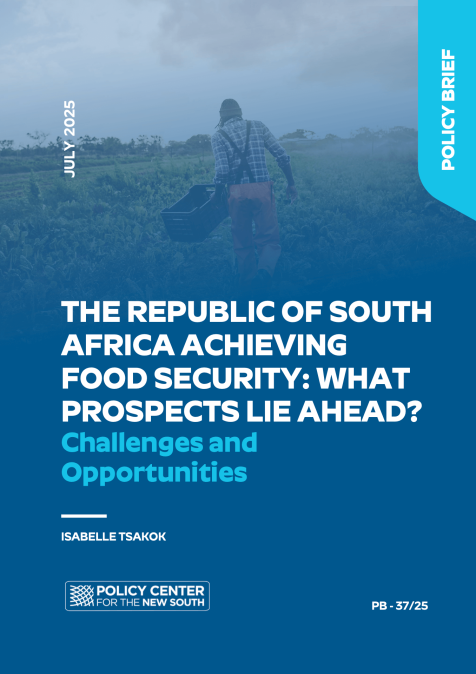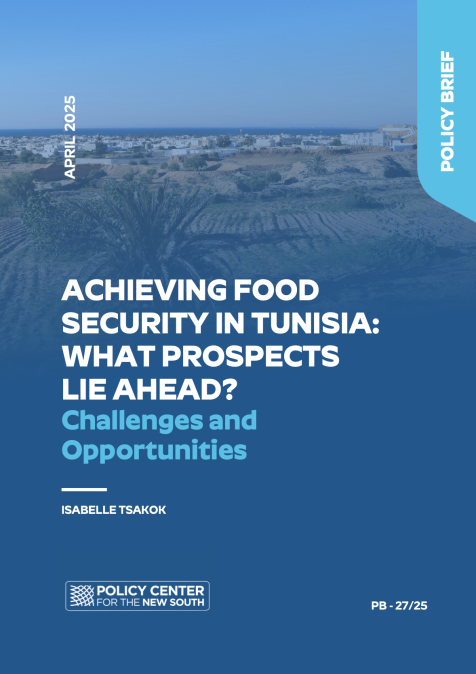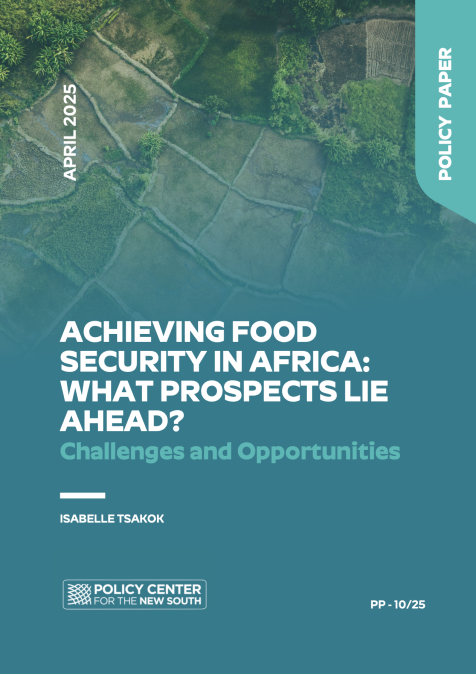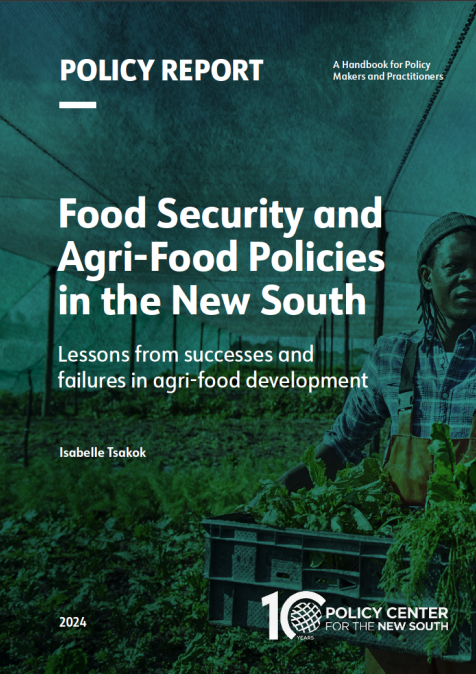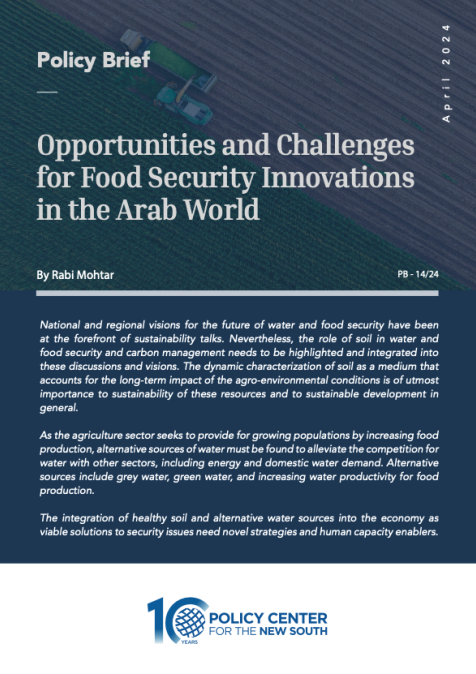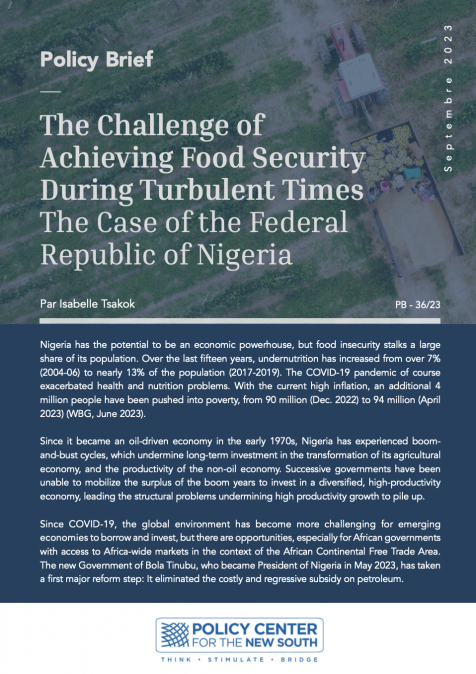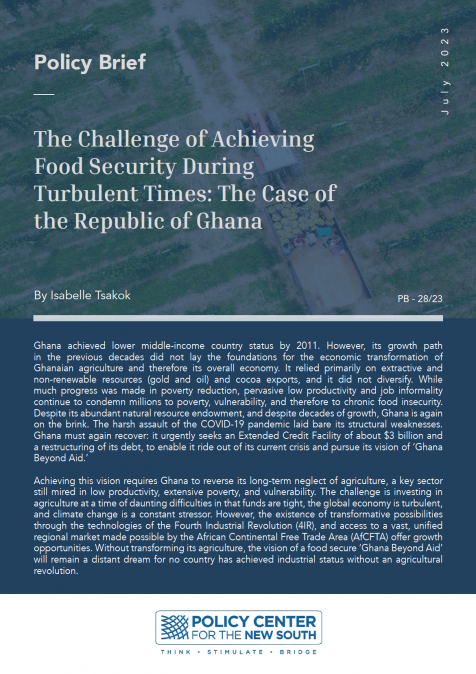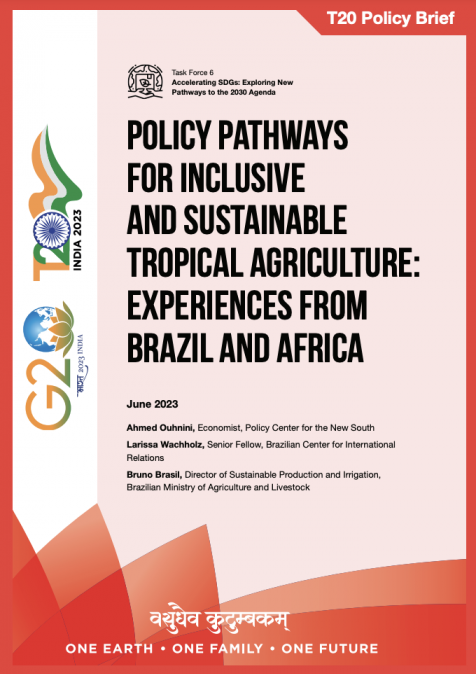Publications /
Policy Brief
Ethiopia presents a unique case among developing countries, having combined major social welfare programs with an East Asian-style development-state approach to investment. However, it differs from its East Asian counterparts in two key areas: it has not maintained decades of uninterrupted political stability, nor has it implemented a comprehensive land reform. Even so, its experience illustrates both the strengths and weaknesses of the East Asian development model.
Despite a decade of high growth and significant poverty reduction in the early 2000s, Ethiopia continues to grapple with widespread poverty, vulnerability, high unemployment, food insecurity, and violent internal conflict. These persistent challenges are now compounded by the existential threat of climate change and a rapidly growing youth population.
The Government of Ethiopia has proposed an ambitious, multi-year agenda of structural reforms aimed at addressing climate change while pursuing its broader development objectives. These reforms include redefining the role of the state in relation to the private sector.
If Ethiopia’s past success in adapting its development strategy is any indication, it may once again be able to turn crisis into opportunity.
Introduction: Scope and Organization
Ethiopia, the only African country never to have been colonized, is often noted in the popular press for its dramatic shifts in governments and remarkable episodes of development amid widespread underdevelopment.[1] Historically known to foreigners as Abyssinia until the mid-20th century,[2] “Ethiopia” in the early 20th century often referred not to a specific geographic entity, but to a broader liberation movement for Black people under colonial yoke (Mefateria, 1995).
A low-income country—with a gross national income per capita of USD 1,110 (2023)[3]—Ethiopia has experienced periods of high growth and significant poverty reduction, though these gains have been marred by locust infestations, recurrent famines, and violent domestic conflicts. With an estimated population of 126.5 million in 2023, it is one of Africa’s most populous nations.[4]
Since the early 20th century, successive Ethiopian governments have embraced varying ideologies: imperial and feudal rule under Emperor Haile Selassie (1916-74); Marxist-Leninist military rule under Mengistu Hailemariam, the DERG regime (1974-91); followed by the rise and eventual dominance of the Ethiopian People’s Revolutionary Democratic Front (EPRDF), which was dissolved in 2019 by its chairman, Abiy Ahmed. He then formed a new political entity, the Prosperity Party, under which he now serves as Prime Minister.[5] Unsurprisingly, these shifts in political leadership and governing philosophies have brought about dramatic changes in the country’s development strategies.
This project brief begins with a brief overview of the changing socio-political environment of both feudal and modern Ethiopia in Section I. Section II focuses on the state of poverty and food insecurity in 21st-century Ethiopia. Section III describes key features of the agricultural sector—a major contributor to the economy, accounting for approximately 32% of GDP (2023) and about 62% of total employment (AfDB, 2024).[6] Sections II and III together provide the background for Section IV, which examines the major trends shaping the challenges and opportunities facing agriculture and agri-food systems, and thus Ethiopia’s broader capacity to strengthen its economy and achieve food security. Based on this analysis, Section V explores different scenarios and their possible consequences for Ethiopia’s prospects of achieving long-term food security.
Section I: Brief Overview of the Socio-Political and Policy Environment in Ethiopia from the Early 20th Century Onward
Dramatic Changes in Governing Philosophies
Ethiopia entered the 20th century under the rule of Emperor Haile Selassie,[7] who was violently deposed in 1974 by the DERG regime—a Marxist-Leninist military junta. The Derg regime (1974-91) imposed socialist policies, including the nationalization of land and industry. It was eventually overthrown by the Ethiopian People’s Revolutionary Democratic Front (EPRDF) (1991-2019), a coalition of four ethnically based military-political groups representing the Tigray, Amhara, Oromo, and Southern Ethiopian peoples.[8]
The current government is led by three of these constituent groups—excluding the Tigray People’s Liberation Front (TPLF)—which were merged in 2019 to form the Prosperity Party. Under the leadership of Meles Zenawi,[9] first under the Transitional Government of Ethiopia as President (1991-95), and then as Prime Minister until 2012, Ethiopia embraced the East Asian developmental state approach to development and enjoyed relative political stability. Zenawi’s tenure of office is praised for its pro-poor growth achievements but criticized for being autocratic and for silencing its political opponents.
Widespread Impoverishment and Recurrent Political Instability under the Feudal System and Beyond
The high concentration in land ownership has been a major source of conflict and underdevelopment in Ethiopia. The country inherited a complex land-tenure system characterized by communal land holdings in the north, private holdings in the south, and significant allocations of land to the church and the state (Cohen, 1974). Under Emperor Selassie’s feudal system, most people were poor sharecroppers in subsistence, rain-fed agriculture, surrendering half to three-quarters of their harvest to landlords who controlled roughly 30% of agricultural land. The church owned over 25% , Emperor Selassie and his family, about twenty 20 %, and the state 18%.[10]
Beyond this oppressive agrarian structure, Ethiopia has endured multiple violent conflicts driven by ethnic tensions, territorial disputes, and political grievances. Chief among these was the Eritrean War of Independence (1961-91), which culminated in Eritrea’s formal secession in 1993, but left peace elusive. Earlier, the Woyane rebellion erupted in Tigray in 1943, and in 1964 Ethiopia fought a border war with Somalia. Most recently, the civil war in Tigray (2020-22) further destabilized the nation.
Although Prime Minister Abiy Ahmed received the Nobel Peace Prize in 2019 for brokering an end to the long-standing Ethiopia-Eritrea conflict, tensions remain high, and the peace remains fragile.
Section II: Poverty and Food Insecurity in Ethiopia
Poverty and Vulnerability Extensive Despite Impressive Reduction During a Decade of High Growth
Poverty is widespread in Ethiopia, regardless of the measurement method, despite significant reductions during a decade of high average annual growth of around 10% (2004-2019). At the extreme poverty line of USD 1.90/day (at the 2011 purchasing power parity), the poverty rate fell from 53.3% in 2000 to 29.6% in 2011. However, when measured at the international poverty line of USD 2.15/day, the rate stood at 27% in 2015 (World Bank Group, May 2017; October 2024). At the lower middle-income poverty line of USD 3.65/day, the poverty rate rose to 65% (2015), and at the upper middle-income level of USD 8.65/day, it reached 90.7% of the population (2015).[11]
These stark differences across poverty lines highlight the high level of vulnerability of the population. Moreover, these figures predate a series of severe shocks: the COVID-19 pandemic; the Russian invasion of Ukraine in February 2022 and the resulting food price inflation; prolonged droughts between 2020 and 2023; locust swarms from June 2019 to February 2022; and the Tigray conflict from 2020 to 2022.
Ethiopia also hosts the fifth-largest refugee population globally and the largest in Africa after Uganda, accommodating over 800,000 refugees fleeing violent conflicts in neighboring countries such as South Sudan, Somalia, Eritrea, Sudan and Yemen (World Bank Group, May 2017).
Key Features of Poverty and Food Insecurity in Ethiopia
Given that approximately 75-80% of Ethiopia’s population lives in rural areas, it is not surprising that poverty is predominantly rural. At USD 2.15/day poverty line, the rural poverty rate was approximately 31%, compared to 11 % in urban areas as of 2015. Poverty in Ethiopia is also multidimensional. For instance, the poverty rate varies significantly with education levels—29% among adults without formal education versus just 3% among those with tertiary or post-secondary education.
Access to basic services remains limited for much of the population: 64% lack electricity; 43% have limited or no access to safe drinking water; 95% lack access to adequate sanitation; but 66% for those who have completed only primary education (World Bank, October 2024).
Food insecurity has also worsened over time. The proportion of food-insecure people (both transient and chronic) was estimated at 8% in 1975, rising to 16% in the drought year of 2003 (World Bank, February 2008), and to 18%—or 20-22 million people—in 2024 (WFP, July 2024). The scale and depth of poverty, along with these disparities in access to services, would have been significantly worse were it not for Ethiopia’s social safety net programs.
Reducing Food Insecurity Through Social Safety Nets
To address the widespread poverty and vulnerability, Ethiopia has implemented three major social safety net programs. These are:
1- The Productive Safety Net Program (PSNP): Established in 2005 as a multi-donor initiative, the PSNP marked a significant shift from emergency-based, in-kind transfers toward predictable, multi-annual, in-cash transfers. These are used to support small-scale, productive public works, such as road construction and reforestation.[12] The PSNP has since grown into one of the largest welfare schemes in Africa. It provides rural households with a combination of cash transfers and employment opportunities in public works.
2- Evidence of the program’s positive impact on food security emerged through comparisons of how poor households fared before and during the Covid-19 pandemic. Among households not covered by the PSNP, the average food gap increased by 0.47 month,[13] compared to only 0.13 month among PSNP beneficiaries. In addition, PSNP-supported households were less likely to reduce spending on health and education (by 7.7%) and on agricultural inputs (by 13%). These findings demonstrate that the PSNP helped cushion the severe effects of the pandemic on poor households (Abay et al., 2020).
3- However, recent compounding crises—including the two-year conflict in Tigray (2020-22), soaring food price inflation (over 40%) triggered by the Russian invasion of Ukraine (February 2022), and ongoing droughts—have severely strained the PSNP. A major funding shortfall has led to the curtailment of standard rations, raising fears of worsening hunger and even starvation (Taylor, March 2024).[14]
4- The Urban Productive Safety Net (UPSN): The rural PSNP was extended to urban areas through the launch of the Urban Productive Safety Net Project in 2017. This program combines public works with livelihood grants targeted at some of the poorest urban households. It also supports direct cash transfers for vulnerable groups, including pregnant women, persons with disabilities, and the elderly, while providing social services to the destitute. The World Bank has proposed expanding the scope of the UPSN to include job assistance, with a particular focus on youth employment and support for refugee communities (World Bank Group, January 2021).
5- The National Food Security Program (NFSP): Financed by the Federal Government, the NFSP aims to assist 5 million chronically food-insecure people during normal years,[15] and an additional 10 million affected by acute food shortages during drought periods. The government allocates grants to regional administrations to fund improved agricultural input packages (seeds and fertilizer), small-scale irrigation and water harvesting projects, as well as voluntary resettlement programs for populations living in food-insecure areas (World Bank Group, February 2008).
Section III: Agriculture and Agri-Food Sector under the Continuing Threat of Climate Change—Importance, Performance and Key Features
Key Features of Ethiopian Agriculture
Broadly speaking, Ethiopia has two main agricultural production systems: (1) the mixed cereal-livestock system in the central and northern highlands, and (2) the livestock pastoral system in the arid to semi-arid lowlands along the southern, eastern and western edges. Ethiopian agriculture is dominated by smallholders, largely rainfed, and remains at a low-productivity subsistence level, for example, 79% of maize produced is consumed by the producing households rather than being commercialized. Mechanization is very limited, with only 13% of the cereal-cropped area using improved seeds. Nearly 50% of farmers lack access to fertilizers (World Bank Group, 2019). Crop farming dominates the sector, with the main food crops being cereals—primarily teff,[16] wheat, sorghum, and barley—which account for around 80% of crop production in Ethiopia (Wakjira et al., November 2024).
Export-oriented crops include coffee, sesame, and high-value floriculture, where medium to large farmers and formal private sector enterprises have a larger presence. Livestock and agro-pastoral activities are also very important,[17] providing livelihoods for more than 12 million Ethiopians and contributing approximately 12-16% of GDP, or 30-35% of agricultural GDP (Gebremeskel et al., 2019). Livestock is a major source of meat, milk, and leather (for domestic and foreign markets), as well as plough oxen for highland farmers.
A Subsistence Agriculture Which Started Its Long Journey of Transformation under Zenawi’s Leadership (1995-2012)
Ethiopia adopted the agriculture-development-led-industrialization strategy (ADLI) from the mid-1990s into the early 2000s. Almost uniquely among Sub-Saharan African (SSA) governments, Zenawi’s government invested heavily in agriculture, spending 16.8% of its annual public expenditure on the sector—well above the Comprehensive Africa Agriculture Development Programme (CAADP) target of 10% specified by the Maputo Declaration in 2003 and reiterated by the Malabo Declaration in 2014—for several years (World Bank Group, June 2019)[18] The government focused on public infrastructure such as roads and small-scale irrigation, improving market access, and expanding agricultural extension services. This high level of investment was critical given the sector’s major importance: it accounts for 36% of GDP, 70% of total employment, and 80% of exports (World Bank Group, 2019).
Agricultural growth did take off, averaging 7% per year, driven by improvements in total factor productivity (TFP). However, this period of high productivity growth and structural transformation was unfortunately not sustained in the subsequent years leading up to 2020 (World Bank Group, June 2022).[19] The agricultural structural transformation stalled largely because the period of major public support and strong growth was relatively short-lived. While yields did increase, they remain low by international standards. Another major challenge is the lack of water control: less than 13% of Ethiopia’s irrigation potential has been developed, with only 4-5% of cultivated land irrigated. In a drought-prone region—as recent experience has amply shown—this lack of effective water management has had devastating consequences.
Agriculture and Agri-Food under the Threat of Climate Change
The frequency and severity of droughts and floods are expected to worsen as climate change accelerates. Beyond the increased likelihood of extreme weather events, global warming threatens to significantly reduce crop yields and increase pest attacks, especially on livestock. In Africa, pests, diseases, and infestations were the second highest cause of crop and livestock production losses between 2008 and 2018. According to the UN FAO, these factors caused a 9% decline in crop and livestock production during that period—greater than the negative impact of extreme temperatures and wildfires. Two particularly harmful pests are the armyworm, which attacks maize, and locusts. Ethiopia may also experience extreme volatility in coffee yields, with projections indicating a drop of over 30 % in production by 2030.
The reduction of natural resources is likely to intensify competition for scarce resources and increase the risk of conflict. Human health is also at risk, as exposure to higher temperatures has been linked to increased incidence of wasting and low birth weight among rural and urban populations in SSA (Welsh, 2021).
Since 2000, Ethiopia has endured multiple severe droughts, including those in 1999/2000, 2002/2003, 2015, 2023, and 2024. The cumulative human toll of these droughts has been enormous: approximately 22 million people in the arid pastoral areas of Ethiopia face food insecurity, while 11.8 million have suffered significantly in drought-affected areas of Afar, Somali, Oromia, former SNNP regions,[20] and Dire Dawa City Administration (World Bank Group, February 2024).
Section IV: Major Trends Shaping Challenges and Opportunities for Agriculture and Agri-Food
Climate change and the youth bulge are the mega-trends shaping both the challenges and opportunities confronting Ethiopia.
Climate Change: An existential Challenge to Ethiopia
Climate change is an existential challenge not only for Ethiopia but for the entire world. However, given Ethiopia’s extensive poverty, vulnerability, and food insecurity, the urgency to implement an effective response strategy is especially critical—and fully recognized by the Government of Ethiopia (GOE). The GOE has an ambitious agenda to build a resilient, high growth (averaging 10% annually), and inclusive economy through its 10-Year National Development Plan (10YNDP), aiming to reduce extreme poverty to 7% by 2030.
The magnitude of the challenge becomes clear when considering projections under a “business as usual” scenario characterized by hot and dry conditions. Beyond the losses in agricultural productivity and livelihoods already noted, climate change is expected to cause widespread damage to hydropower generation and various infrastructure sectors. This would generate annual GDP losses of approximately 1.0-1.5% during 2024-30, potentially rising to as high as 5% per year by the 2040s (World Bank Group, 2024).
There is also significant uncertainty about whether the future climate will be predominantly hot and dry or wet and warm. This uncertainty itself makes the challenge of climate change even more daunting, as it requires preparing for different contingencies, including decentralizing centers of effective response.
Ethiopia’s Youth Bulge Poses a Major Socio-Economic Challenge
As in much of Africa, Ethiopia’s youth (age 15-29) bulge could be a demographic dividend but may instead become a major socio-economic problem.[21] About 70% of Ethiopia’s population is under 30 years of age.[22] More than a million young men and women enter the labor market annually, but far fewer job opportunities are available (Bezu, April 2017). Women fare worst in the job market. The number of new job seekers has increased recently, with roughly two million people reaching working age each year (World Bank, April 2025). Ethiopia’s labor force is predominantly young and largely uneducated—about 76% of employed Ethiopians have not completed primary school (World Bank, 2021). Most youth live in rural areas, as Ethiopia remains primarily rural—77% in 2023 (WDI).[23] Rural youth are mainly engaged in the informal sector of subsistence agriculture, often as unpaid family labor. Consequently, underemployment is a much bigger problem than formal open unemployment. Meeting the challenge of productively employing rural youth requires addressing multiple issues, including:
1- Agricultural land scarcity due to increasing population pressure: The contentious issue of foreign firms¾often including investors from other Sub-Saharan African (SSA) countries—purchasing or leasing large tracts of agricultural land (commonly referred to as “land grabbing”) must be addressed. It is crucial to strike a balance that respects the rights and livelihoods of local populations while providing legal clarity and assurance to investors. This challenge must be managed within the evolving legal framework supporting the AfCFTA (GRAIN and Coulibaly, November 2024).
2- Complexity of land tenure systems and insecurity of tenure within an overall constitutional framework in which all land is owned by the state:[24] Ethiopia has decentralized land administration and registration to the Kebele level, aiming to allocate land to households and clarify use rights through certification. However, significant challenges remain (Byamugisha, ed. 2014).
3- Lack of access to finance: Rural youth face constraints including limited access to credit or capital needed to start businesses, among other challenges (Shuker et al., February 2024)
4- Underdeveloped irrigation systems: Despite abundant surface and groundwater resources and an estimated 3.3 million hectares of potential irrigable land, less than 5% of this potential is currently utilized. Funding and management of irrigation infrastructure remain problematic (D.I.E., 2017; see Annex I) .
5- Low education and skill levels: Ethiopia has a low Human Capital Index (HCI) of 0.38 (2020), below the SSA average of 0.40 (2020) (World Bank Group, 2021).[25]
To the extent that productive rural youth employment does not improve significantly, unemployed rural youth will continue to swell the ranks of the urban unemployed, which were already high at 20% in 2019.[26] About 15% of youth are not in employment, education or training (NEET) (World Bank, April 2021). Moreover, urban employment is largely characterized by low-quality jobs, mainly in the services sector—78% in 2019 compared to 67% in 2014.
While the public sector continues to offer relatively good formal sector employment, it primarily targets highly skilled labor. However, public sector employment is already saturated, and given mounting fiscal constraints, it cannot be relied upon as a major source of future job creation. Notably, unemployment is paradoxically higher among those who have completed secondary education (25%) than among those with no formal education (15%). However, unemployment is lowest among those who have attained post-secondary education.
Section V: What Prospects for Achieving Food Security? A Reform Scenario
The Long March to Achieve Food Security for All:
At the dawn of the 21st century, Ethiopia emerged as one of Africa’s fastest growing economies, accompanied by substantial reductions in poverty. However, the momentum was not sustained. In recent years, poverty, vulnerability, and food insecurity have worsened.
To change course, Ethiopia must urgently restart the stalled structural transformation of both its agricultural sector and broader economy. The GOE has demonstrated a clear recognition of the formidable challenges posed by climate change and the growing youth bulge. This is reflected in its ambitious 10YNDP, the 2019 Home Grown Economic Reform Agenda (HGERA), and the Climate Resilient Green Economy strategy.
Under the reform scenario envisioned by the GOE, a comprehensive package of reforms and investments is planned to boost productivity and foster inclusive, climate-resilient growth. These include:
- At the economy-wide level: (i) macroeconomic stabilization; (ii) a competitive exchange rate system; (iii) a more enabling business environment to incentivize private sector development; (iv) infrastructural investments, particularly in electricity generation and distribution; (v) investments in education, health, research and development in different fields; and (vi) strengthening the social safety net system.
- At the agriculture and agri-food level: (i) sustainable management of land and water resources, with a focus on reversing widespread land degradation and a better mobilization of surface and groundwater resources; (ii) infrastructure investments to improve market access—including those enabling regional trade under the AfCFTA—as well as access to electricity and digital connectivity; (iii) enhanced agricultural research, extension, education and training services; and (iv) strengthened veterinary services for pastoral areas.
Only a structural reform scenario offers a realistic path toward addressing the mega-challenges of climate change and the youth bulge. A continuation of the business-as-usual approach—especially in the context of ongoing regional conflicts, whether in Tigray, Amhara, or other parts of the country—will be very costly. While the reform agenda is financially demanding, the cost of inaction and deferred transformation is likely to be far greater.
Conclusion
Ethiopia achieved high growth and notable poverty reduction during the implementation of its Agricultural Development-Led Industrialization (ADLI) strategy, which drew inspiration from the East Asian development-state model. Unfortunately, this period of progress was short-lived, as Ethiopia was unable to sustain political stability or implement a unimodal land distribution system that would provide land tenure security to smallholders—an approach successfully adopted by the “Asian dragons”, whose economic takeoff was rooted in strong agricultural foundations.[27]
The road ahead will be challenging. Yet Ethiopia has a history of overcoming adversity and transforming crises into opportunities. This moment may present a critical juncture to revisit the development-state model that previously delivered results—this time adapted with lessons learned and enriched by insights from a broader group of High Performing Asian Economies (HPAEs), such as Malaysia, Indonesia and Thailand.[28] The hope is that this reflection will spark vigorous public debate and bold reform implementation as Ethiopia charts a course toward building a more productive, resilient and inclusive economy.
Annex I—Ethiopia: Irrigable Potential and the Awash Basin—A Cautionary Tale
Ethiopia has significant irrigable potential, yet its agriculture remains predominantly rainfed and characterized by low productivity. Yields per hectare for major cereal crops remain below international levels. The agricultural sector—dominated by smallholders—contributes approximately 35% of GDP, employs 73% of the labor force, and accounts for 78% of export earnings (Mekonnen et al., October 2024).
The country possesses abundant surface and groundwater resources, with an estimated 3.3 million hectares of potentially irrigable land spread across 12 major river basins. However, only a fraction of this capacity is currently utilized. Kassa and Andualem (2020) estimate that less than 5% of Ethiopia’s total irrigated land is in use, while Haile (2015) places the figure at only 10–12% of potential irrigable land.
The Awash Basin—Ethiopia’s most intensively irrigated region and entirely within its borders—illustrates both the promise and pitfalls of irrigation development. While an estimated 77% of the irrigable area in the basin is cultivated, 20% of land equipped for irrigation remains unused, indicating substantial underutilization and inefficiencies.
Multiple challenges hinder the efficient use of irrigation in the basin. Management is a major constraint: 96% of irrigation scheme managers, extension agents, and leaders of water users’ associations (WUAs) are unaware of total water withdrawals or seasonal water requirements. Moreover, 14% of surveyed schemes have neither traditional water committees nor WUAs, and only 21% are organized into legally registered associations. Women’s participation in governance is notably low, with only 58 out of 489 irrigation schemes including women as committee members.
Maintaining funding is another critical weakness. Many schemes lack clear strategies to finance operation and maintenance. Nearly 40% collect user contributions only after a breakdown occurs, and 17% report no maintenance contributions at all. Furthermore, many systems serve more users than originally planned, leading to water scheduling challenges, increased conflicts, and water theft.
External constraints also limit the impact of irrigation systems. These include inadequate infrastructure¾such as roads and electricity limited access to markets for both agricultural inputs and outputs, and, in arid regions, the prevalence of malaria and harsh climatic conditions that hinder productivity and expansion (D.I.E. 07/2017).
The key takeaway is that the institutional framework governing irrigation is a decisive factor in their expansion, functionality, and long-term sustainability.
While water availability and control are the lifeblood of agriculture, access to water alone is insufficient. The ability of farmers to effectively manage and utilize these resources is essential for transitioning to high-productivity agriculture. More broadly, the institutions that govern resource management—and the incentives they create¾are just as critical, if not more so, than the physical availability of resources in determining agricultural performance.
Bibliography
Abay, Kibrom A., Guush Berhane, John Hoddinott, KibromTafere. November 2020. “COVID-19 and Food Security in Ethiopia: Do Social Protection Programs Protect? “ Policy Research Working Paper 9475. https://openknowledge.worldbank.org/server/api/core/bitstreams/fa45f563-1032-5ceb-b4dd-ee6aadda534e/content
African Development Bank (AfDB) 2024. African Economic Outlook. https://www.afdb.org/en/countries/east-africa/ethiopia/ethiopia-economic-outlook
Bezu, Sosina. April 18, 2017. “Ethiopia can convert its youth bulge from a political problem into an opportunity”. The Conversation. https://theconversation.com/ethiopia-can-convert-its-youth-bulge-from-a-political-problem-into-an-opportunity-75312
Byamugisha, Frank, F.K. (Edit) 2014. Agricultural Land Redistribution and Administration in Sub-Saharan Africa: Case Studies of Recent Reforms”. Report # 87063. World Bank. https://documents1.worldbank.org/curated/en/909671468270272353/pdf/Agricultural-land-redistribution-and-land-administration-in-Sub-Saharan-Africa-case-studies-of-recent-reforms.pdf
Cohen, John M. 1974. “Peasants and Feudalism in Africa: The Case of Ethiopia “ Source: Canadian Journal of African Studies / Revue Canadienne des Études Africaines , Vol. 8, No. 1 (1974), pp. 155-157 Published by: Taylor & Francis, Ltd. on behalf of the Canadian Association of African Studies Stable URL: https://www.jstor.org/stable/483880
D.I.E. DeutschesInstitut für Entwicklingspolitik. German Development Institute.07/2017.Unlocking the Irrigation Potential in Sub-Saharan Africa: Are Public Private Partnerships the Way Forward? Briefing Paper. https://ppp.worldbank.org/public-private-partnership/sites/ppp.worldbank.org/files/2022-06/Briefing_paper_on_irrigation.pdf
Foreign Policy Association. “Land Grabbing Upsets Ethiopians”. Posted by Rishi Sidhu. https://fpa.org/land-grabbing-upsets-ethiopians/#:~:text=Discontent%20from%20%E2%80%9Cland%20grabbing%E2%80%9D%20in,size%20of%20Belgium%20%E2%80%93%20to%20Saudi
GRAIN and Mohamed Coulibaly. Nov 28, 2024. “The AfCFTA and land in Africa: towards a surge in land grabbing?” https://grain.org/en/article/7213-the-afcfta-and-land-in-africa-towards-a-surge-in-land-grabbing
Gebremeskel, Esayas Nigatu, Solomon, Desta, and Girma K. Kassa. 2019.Pastoral Development in Ethiopia Trends and the Way Forward. World Bank and International Fund for Agricultural Development (IFAD). https://openknowledge.worldbank.org/server/api/core/bitstreams/e1e2c514-0068-5e8a-888f-4392ce852bfc/content
Haile, G. G. 2015. Irrigation in Ethiopia, a Review. Journal of Environment and Earth Science 5(15), 141– 148.
Kassa, M., and Andualem, T. G. 2020. “Review of Irrigation Practice in Ethiopia, Lessons from Israel.” Irrigation & Drainage Systems Engineering, 9(1), 1–6.
Mefateria, Getachew. FALL 1995. THE ETHIOPIAN CONNECTION TO THE PAN-AFRICAN MOVEMENT. Source: Journal of Third World Studies, Vol. 12, No. 2, HISTORICAL AND CONTEMPORARY THIRD WORLD DEVELOPMENTS (FALL, 1995), pp. 300-325 Published by: University Press of Florida. https://jstor.policycenterforthenewsouth.ma/stable/pdf/45197577.pdf?refreqid=fastly-default%3A2f948f5ae489f39e88c474e728a04307&ab_segments=0%2Fbasic_search_gsv2%2Fcontrol&initiator=search-results&acceptTC=1
Megquier, Shelley and Kate Belohav. Dec. 2014. “Ethiopia’s Key: Young people and the Demographic Dividend.” Population Reference Bureau (PRB) https://www.prb.org/wp-content/uploads/2015/01/ethiopia-demographic-dividend-policybriefa.pdf#:~:text=Today%2C%2045%20percent%20of%20Ethiopia's,percent%20is%20under%20age%2030.
Taylor, Liam. 28 March 2024 “As starvation looms, Ethiopia’s social safety net programme faces a funding gap. “ The New Humanitarian.https://www.thenewhumanitarian.org/news-feature/2024/03/28/starvation-looms-ethiopias-social-safety-net-programme-faces-funding-gap
Shuker, Mohammed Fuad and Hakim Hashim Sadik. Feb 29, 2024. “A critical review on youth unemployment in Ethiopia”. International Journal of Adolescence and Youth. Vol. 29, 2024. https://www.tandfonline.com/doi/full/10.1080/02673843.2024.2322564#abstract
Wakjira, Mosisa Tujuba , Nadav Peleg , Johan Six, Peter Molnar. 15 November 2024. “Current and future cropland suitability for cereal production across the rainfed agricultural landscapes of Ethiopia” Agricultural and Forest Meteorology. Vol 358, 110262. https://www.sciencedirect.com/science/article/pii/S0168192324003757
Welsh, Caitlin. April 27, 2021. "Climate Change Impacts in Africa." Center for Strategic and International Studies (CSIS) (2021): https://www.jstor.org/stable/resrep37450 https://jstor.policycenterforthenewsouth.ma/stable/pdf/resrep37450.pdf?refreqid=fastly-default%3Ae726836a5b90409ebad7981e875c66b7&ab_segments=0%2Fbasic_search_gsv2%2Fcontrol&initiator=search-results&acceptTC=1
Witten, Montgomery Wray. 2007. The Protection of Land Rights in Ethiopia. Afrika Focus, Vol. 20, Nr. 1-2, pp. 153-184. (Former Dean, Mekelle University, Law Faculty. Mekelle, Tigray, Ethiopia) file:///Users/isabelletsakok/Downloads/afoc-article-p153_7%20(1).pdf
World Development Indicators. GNI per capita, Atlas Method. https://data.worldbank.org/indicator/NY.GNP.PCAP.CD
World Bank. February 2008. Ethiopia Agriculture and Rural Development Public Expenditure Review 1997/98 – 2005/06. Report No. 41902. https://openknowledge.worldbank.org/server/api/core/bitstreams/8e5a97a9-c367-5fcd-a01c-86956bacfded/content
World Bank Group. March 30, 2016. ETHIOPIA SYSTEMATIC COUNTRY DIAGNOSTIC ETHIOPIA: PRIORITIES FOR ENDING EXTREME POVERTY AND PROMOTING SHARED PROSPERITY. Report no. 100592-ET. https://documents1.worldbank.org/curated/en/913611468185379056/pdf/100592-REVISED-P154064-PUBLIC-Ethiopia-SCD-March-30-2016-web.pdf
World Bank Group. May 22, 2017. Country Partnership Framework for the Federal Democratic Republic of Ethiopia FOR THE PERIOD FY18–FY22. Report No. 119576-EThttps://documents1.worldbank.org/curated/en/202771504883944180/pdf/119576-revised-Ethiopia-Country-Partnership-Web.pdf
World Bank Group. June 2019. MAXIMIZING FINANCE FOR DEVELOPMENT (MFD) IN AGRICULTURE AND FOOD SYSTEMS IN ETHIOPIA AN ANALYSIS OF BEEF, COFFEE, AND MAIZE. https://openknowledge.worldbank.org/server/api/core/bitstreams/d00fec58-7f7a-560a-a190-9ea3a18f4eff/content
World Bank Group. 2021. The Human Capital Index 2020 Update: Human Capital in the time of COVID-19. https://documents1.worldbank.org/curated/en/456901600111156873/pdf/The-Human-Capital-Index-2020-Update-Human-Capital-in-the-Time-of-covid-19.pdf
World Bank Group. Jan 14, 2021. Towards an inclusive and empowered Ethiopia: Improving Social Safety Nets to Reduce Urban Poverty. https://www.worldbank.org/en/results/2021/01/14/towards-an-inclusive-and-empowered-ethiopia-improving-social-safety-nets-to-reduce-urban-poverty
World Bank. April 2021. Ethiopia: Employment in urban and rural Ethiopia. Report No: Report # AUS0002202.https://documents1.worldbank.org/curated/en/717091632198808079/pdf/Employment-in-Urban-and-Rural-Ethiopia.pdf
World Bank Group (WBG). 2022-06-17. Ethiopia’s great transition: the next mile Ethiopia - Country Economic Memorandum. Report No: AUS0002952. Report No: AUS0002952. https://openknowledge.worldbank.org/server/api/core/bitstreams/cc903653-133b-541c-ad29-96b98259b882/content
World Bank Group. Feb 2024. Ethiopia: Country Climate and Development Report.https://openknowledge.worldbank.org/server/api/core/bitstreams/715c3822-4a9d-437f-8b3c-89585f7fe3b0/content.
World Bank. Oct. 2024 Ethiopia: Poverty & Equity Brief. https://documents1.worldbank.org/curated/en/099729001032529868/pdf/IDU-0d71cf48-d406-42c0-95e9-029edd03f6c3.pdf
World Development Indicators. Ethiopia: Rural population as a % of total population, 2023. https://data.worldbank.org/indicator/SP.RUR.TOTL.ZS?locations=ET
World Food Program (WFP) July 02, 2024. Ethiopia: Food and Nutrition Security Update: May 43, 2024.https://reliefweb.int/report/ethiopia/ethiopia-food-and-nutrition-security-update-key-message-31-may-2024#:~:text=Between%2020%20and%2022%20million,20%25%20are%20chronically%20food%20insecure.
World Bank. April 24, 2025. Ethiopia Overview. https://www.worldbank.org/en/country/ethiopia/overview
-------------------------------------------
[1] Liberia is the other African country that was not colonized in the traditional sense of the term. In 1847, it declared its independence from the American Colonization Society (ACS, founded 1816), which was financed by the US government. Liberia was settled by free Blacks from the United States and received financial support from the US government through the ACS.
[2] The empire of Abyssinia, which lasted from around 1270 to 1974, encompassed modern-day Ethiopia and Eritrea. It was ruled by the Solomonic dynasty, whose last emperor was Haile Selassie.
[3] The July 2024-FY 2025 income country classification (in US $) by the World Bank is:
Low income: 1,145 or less; lower middle income: 1,146- 4,515; upper middle income: 4,516-14,005; high income: higher than 14, 005. Ethiopia is expected to become a lower middle-income country by 2025.
[4] The annual population growth rate of Ethiopia is high, at 2.5% (2024). The most populous nation in Africa is Nigeria with approximately 232.6 million people (2024). Nigeria does not have the highest population density in Africa, however. Mauritius does—at around 630 inhabitants per sq. km. Total land area of the island of Mauritius is only about 2,030 sq. km. Its total population is around 1.3 million (2024))
[5] Ahmed merged three political parties: the Amhara Democratic Party (ADP), the Oromo Democratic Party (ODP), and the Southern Ethiopian People’s Democratic Movement (SEPDM) to form the Prosperity Party. He did not include the Tigray People’s Liberation Front (TPLF) which was also a member of the EPRDF.
[6] Note alternative estimates for 2018 were: 36% of GDP; 70% of total employment (World Bank Group, 2019). Regardless of the set of estimates used, the central importance of agriculture remains indisputable.
[7] Emperor Haile Selassie, born July 23, 1892, was assassinated on August 27, 1975, in the Jubilee Palace, Addis Ababa. Emperor Selassie was a descendent of the Solomonic dynasty, which traces their lineage to King Solomon of Israel and the Queen of Sheba¾figures believed to have lived in the 10th century BCE.
[8] The ethnic-political parties are: (1) Tigray People’s Liberation Front (TPLF); (2) the Amhara Democratic Party (ADP); (3) the Oromo Democratic Party (ODP); and (4) Southern Ethiopian People’s Democratic Movement (SEPDM).
[9] Meles Legesse Zenawi Asres, born May 08, 1955, died on August 20, 2012. He was Prime Minister from August 1995 until August 20, 2012. He was a Tigrayan soldier-politician. Zenawi was also the leader of the TPLF.
[10] “Land grabbing” has become a major issue in modern Ethiopia as in much of SSA. Land grabs refer to the sale or long-term lease to foreign governments of large expanses of agricultural land. For example, Ethiopia’s policy is to lease 3 million ha. of land—the size of Belgium—to Saudi Arabian, Indian, Chinese and other firms. According to IFPRI, in response to the stark food price increases of 2007-08, capital-rich but resource-poor countries such as Saudi Arabia, United Arab Emirates, and China began acquiring land in developing countries¾70% of which are in SSA (Foreign Policy Association, posted by Rishi Sidhu).
[11] There has been no update on the poverty rate since 2016.
[12] The PSNP is funded by a consortium of donors, including the WFP, the EU, USAID (until it was dissolved by President Trump in early 2025), the Danish International Development Agency, Global Affairs Canada, Ireland’s Department of Foreign Affairs, Royal Netherlands Embassy, Swedish International Development Agency, UK Department of International Development, the United Nation’s Children Fund, and the World Bank. Phase 4 of the project (2015-20) had a budget of US$ 2.6 billion. However, for the current Phase 5 (2021 to December 2025), there is a risk of a funding gap due to ongoing crises and increasing demands.
[13] The food gap refers to the number of months during which a household was unable to meet its food needs.
[14] By 2024, the PSNP was assisting some 8 million poor and vulnerable people.
[15] It is believed that around 8 million people in Ethiopia are food insecure even during normal (non-drought) seasons. (World Bank, February 2008).
[16]Teff is a highly nutritious ancient grain native to Ethiopia and Eritrea. It is the tiniest of grains.
[17] The major pastoral areas include the Afar, Ethio-Somali, Oromia and Gambella Regions, and Southern Nations, Nationalities, and Peoples’ Region (SNNPR). Small numbers of pastoral and agropastoral (PAPs) also reside in the Benishangul-Gumuz (BGMZ) Region and Dire Dawa Administration (Gebremeskel et al., 2019).
[18] As a comparison, neighboring Kenya spent only 2.3% of total public expenditure on agriculture (WBG, June 2019).
[19] Unlike the previous decade, total factor productivity (TFP) declined during 2011-20 (WBG, 2022).
[20] SNNP: Southern Nations, Nationalities, and Peoples. The SNNP was a regional state in southwestern Ethiopia. On August 23, 2023, the region was split into two regions following a referendum. It was split into the South Ethiopia Regional State and the Central Ethiopia Regional State.
[21] In 2014, the population under 15 years old was 45 % of the total population and under 30, 71%. On the assumption that fertility continues to decline—during 1990-2011, fertility declined from 7.2 children over the course of a woman’s lifetime to 4.8—and Ethiopia continues to make investments in health and education, fertility will continue to decline to 2.6 children over the course of a woman’s lifetime. In such a scenario, the working age population will then become larger than the number of dependent children and elders (2030). In such a scenario, a demographic dividend occurs when the working-age population outnumbers the dependents (Megquier et al., December 2014).
[22] Assuming a total population of 126.7 m (2023), 70% of total = 88.55 million.
[23] Ethiopia is more rural than the SSA average of 57% (2023) and even exceeds the average for low-income countries worldwide, which stands at 65% (2023) (WDI).
[24]The right to ownership of rural and urban land, as well as of all natural resources, is exclusively vested in the State and in the
peoples of Ethiopia. Ethiopian peasants have the right to obtain land without payment and the protection against eviction from their possession. The implementation of this provision shall be specified by law; Ethiopian pastoralists have the right to free land for grazing and cultivation as well as the right not to be displaced from their own lands. The implementation shall be specified by law; 40. 6. Without prejudice to the right of Ethiopian Nations, Nationa- lities, and Peoples to the ownership of land, government shall ensure the right of private investors to the use of land on the basis of payment arrangements established by law. Particulars shall be determined by law (Witten, 2007).
[25] This index means that a child born in Ethiopia in 2020 will achieve only 38% of his/her development potential. 2020 was the year of the COVID-19 pandemic.
[26] Rural-urban and other forms of internal migration are relatively limited—only about 5% of Ethiopians have migrated to their current place in recent years. In neighboring Kenya and Uganda, internal migration is 20% and 25% respectively. Factors that contribute to limited migration include problems of transferring Kebele IDs to urban IDs, and the land registration system (WBG, 2024).
[27] The Asian dragons are Hong Kong, Singapore, South Korea and Taiwan. They are also referred to as the Asian Tigers. South Korea and Taiwan had significant agriculture sectors.
[28]Source: The East Asian Miracle: Economic Growth and Public Policy (Oxford University Press for the World Bank, 1993). In addition to the four Asian Tigers, the book discusses the three High Performing Asian Economies (HPAEs) of Malaysia, Indonesia and Thailand. All three countries have significant agriculture sectors. Regarding “successful” development experiences, there are both supporters and critics.

